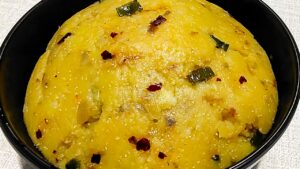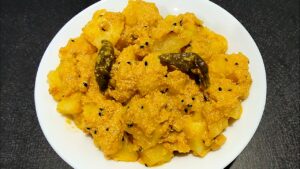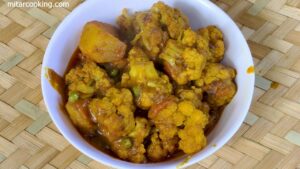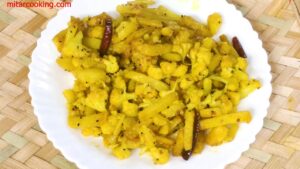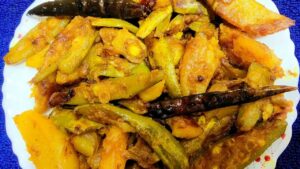Potato curry is a beloved dish enjoyed worldwide, particularly in India. This recipe combines tender boiled potatoes with a rich tomato-based gravy, creating a delightful fusion of flavors.
Whether you’re an experienced cook or a beginner, this potato curry is a must-try addition to your menu. It pairs perfectly with rice, roti, paratha, or puri.
The aromatic roasted spice powder infuses layers of flavor into this dish, making it a delicious choice for lunch or dinner.
Let’s dive into the kitchen and start our culinary adventure with this irresistible Potato Curry Recipe.
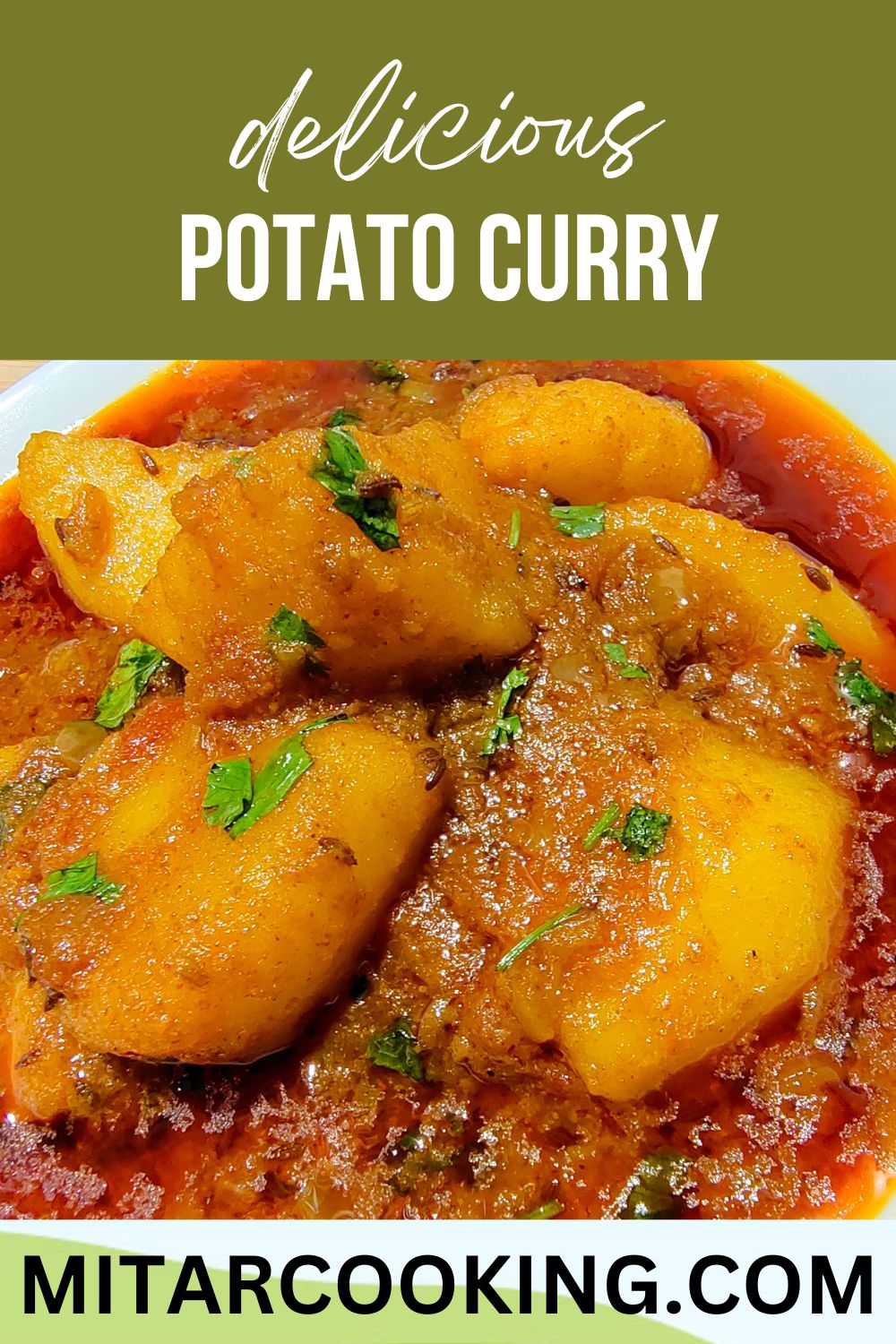
Key Takeaways:
- Potato Curry Appeal: Potato curry is globally cherished, known for its flavorful blend of boiled potatoes and aromatic tomato-based gravy.
- Universal Delight: This recipe suits both seasoned chefs and novice cooks, offering a delicious addition to your menu.
- Versatile Pairings: Serve potato curry with rice, roti, paratha, or puri for a satisfying meal.
- Flavorful Spice Blend: Aromatic roasted spice powder adds layers of flavor, making it perfect for lunch or dinner.
- Aromatic Experience: As you cook, savor the delightful aroma of the roasted spices for an enhanced culinary experience.
The Ingredients
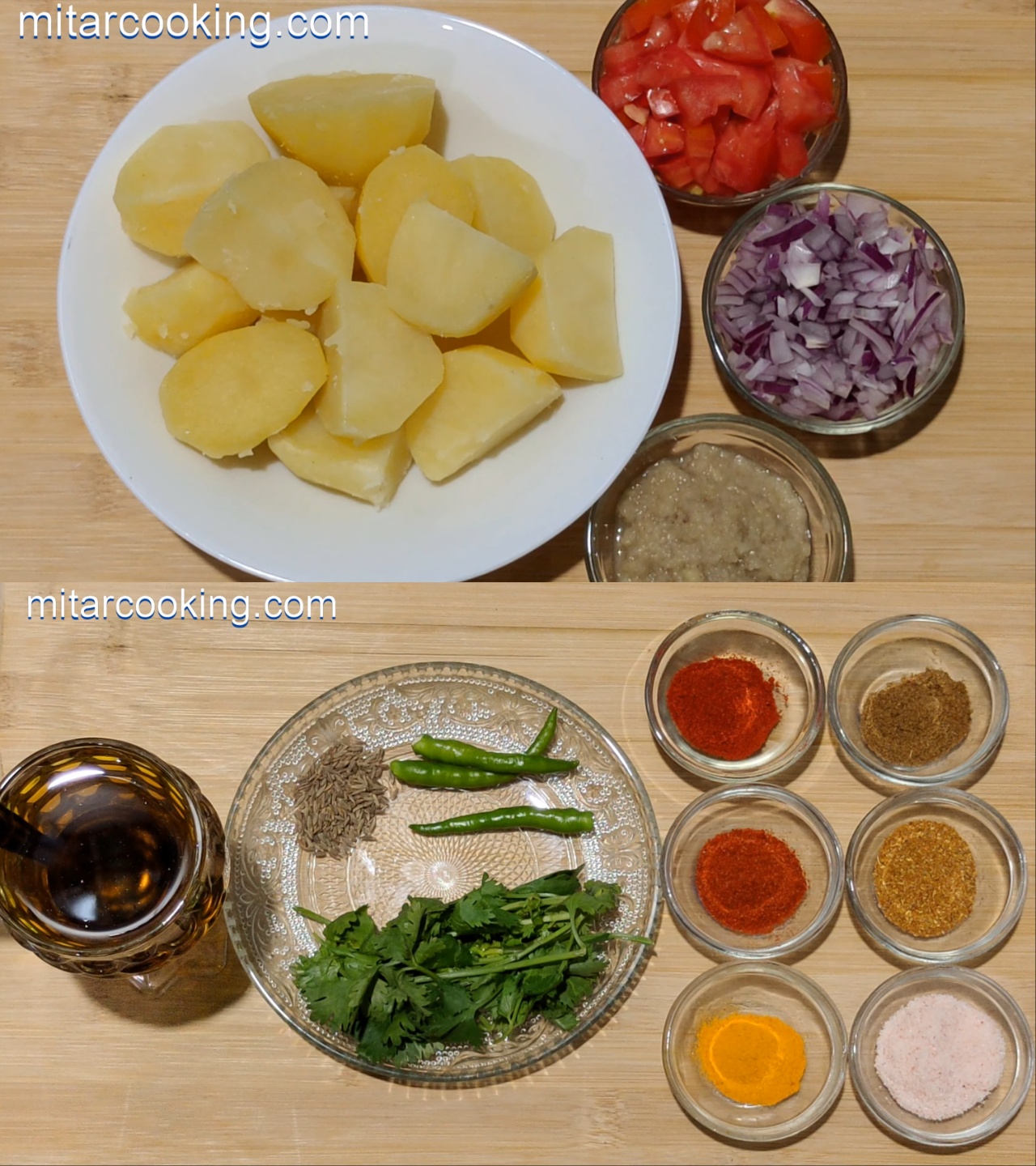
- Potatoes: 400 gm (cut into halves, boiled & peeled)
- Tomato: 100 gm (chopped)
- Onion: 50 gm (chopped)
- Ginger-garlic paste: 2 tbsp
- Cumin powder: ½ tbsp
- Roasted spice powder: 1 tbsp (coriander seeds + cumin seeds + dry red chili dry roasted & grounded)
- Kashmiri red chili powder: 1 tbsp
- Red chili powder: 1 tbsp
- Turmeric powder: 1 tbsp
- Green chilis: 3 pieces
- Coriander leaves: 5 gm
- Cumin seeds: ½ tbsp
- Mustard oil: 3 tbsp
- Salt to taste
How to Cook Potato Curry (Step by Step Images)?
1. Place a wok on the gas stove and heat it. Once the wok is hot, add 3 tbsp of mustard oil and allow it to heat up.
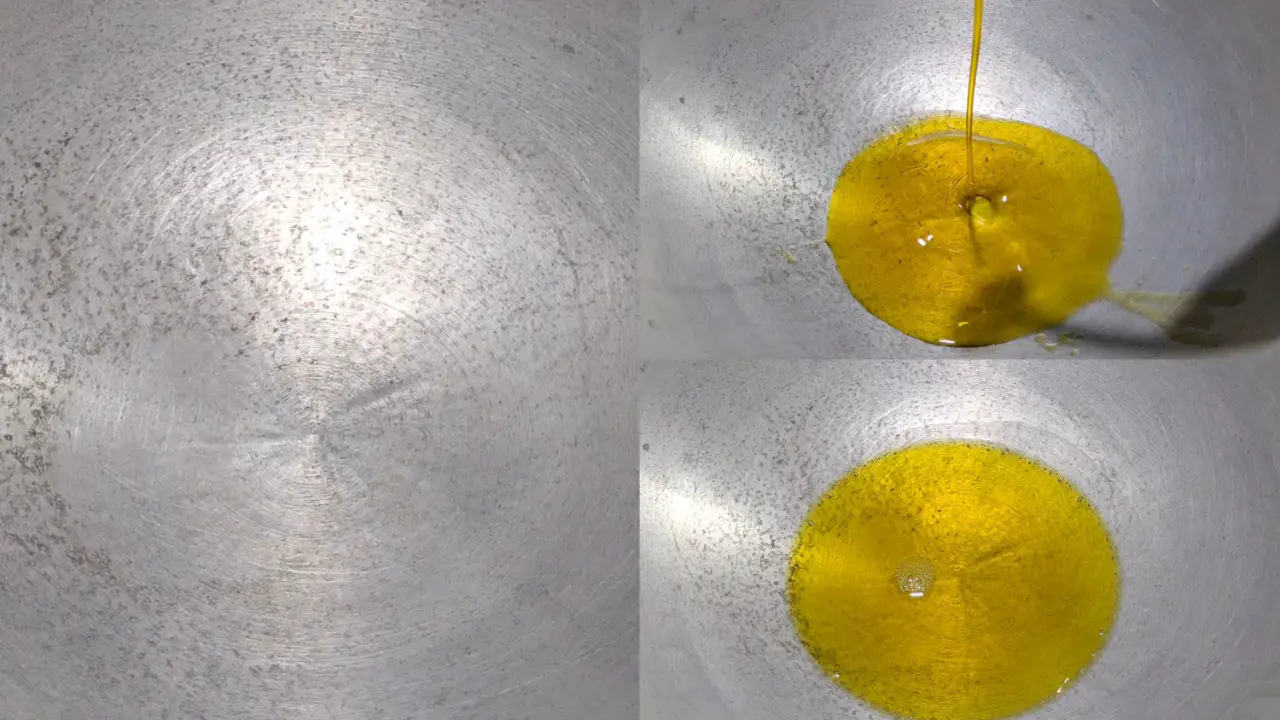
2. When the oil is hot, add cumin seeds. Sauté them until they emit a fragrant aroma, then add the chopped onions. Sauté the onions for 3 minutes.
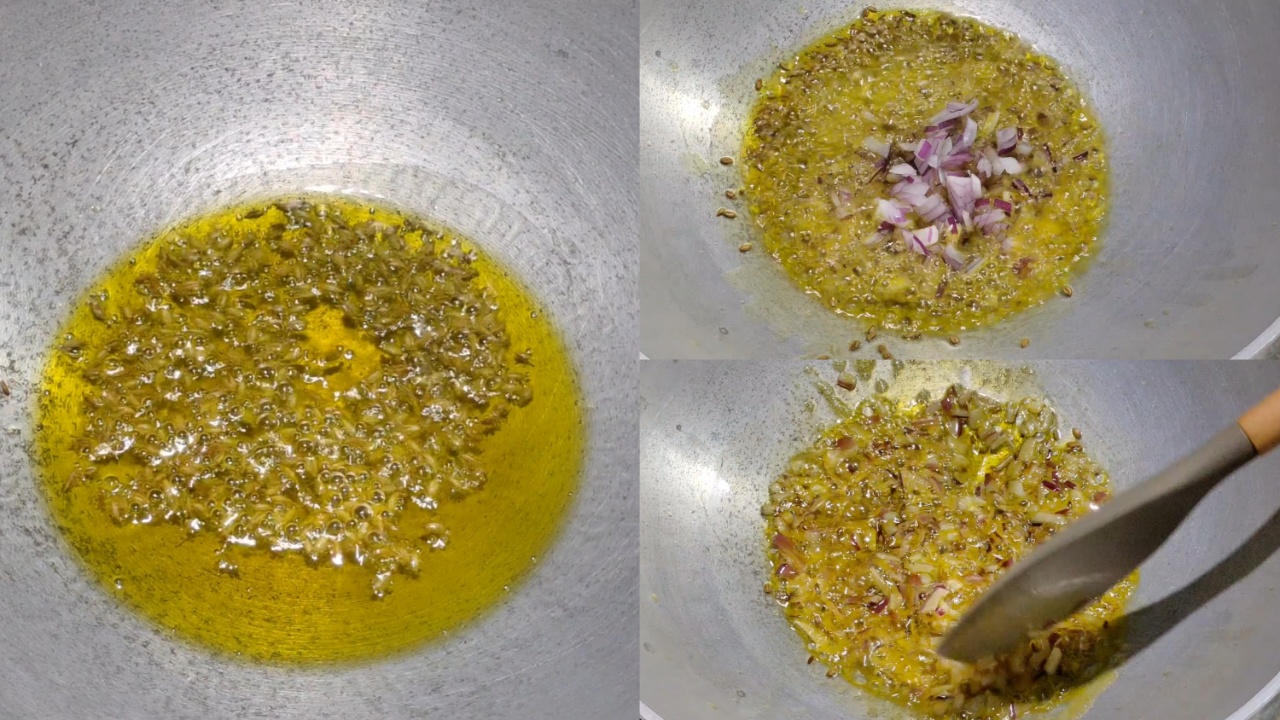
3. Once the onions are sautéed, add the chopped tomatoes and sauté for an additional 2 minutes.
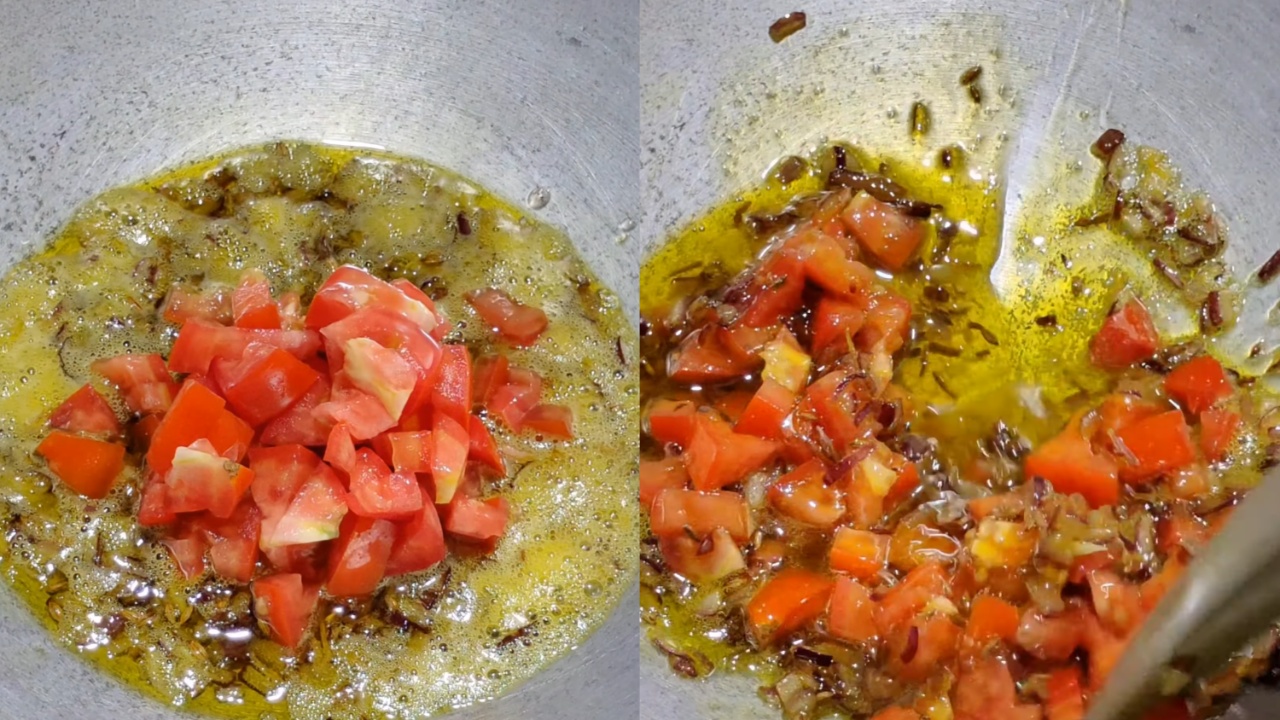
4. When the tomatoes have cooked down and lost their moisture, introduce the ginger-garlic paste. Stir until the raw smell evaporates.
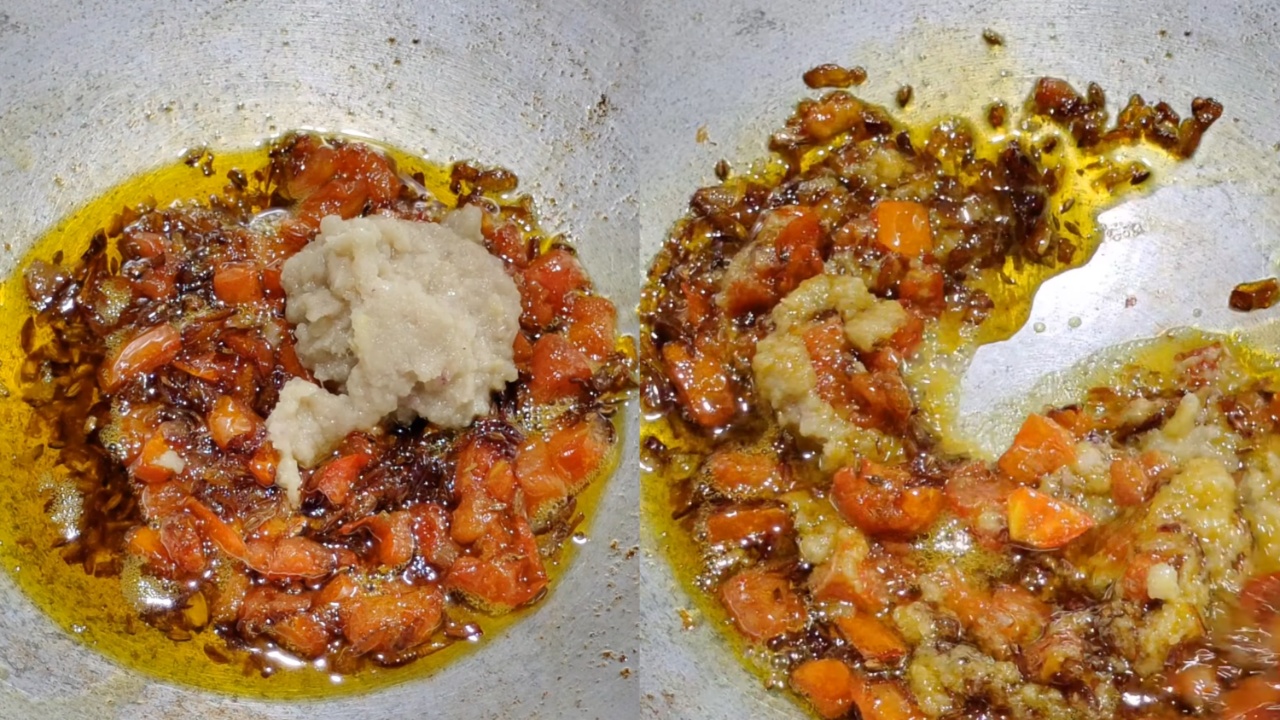
5. Once the raw smell of the ginger-garlic paste is gone, incorporate turmeric powder, cumin powder, Kashmiri red chili powder, and regular red chili powder. Stir and thoroughly mix the spices.
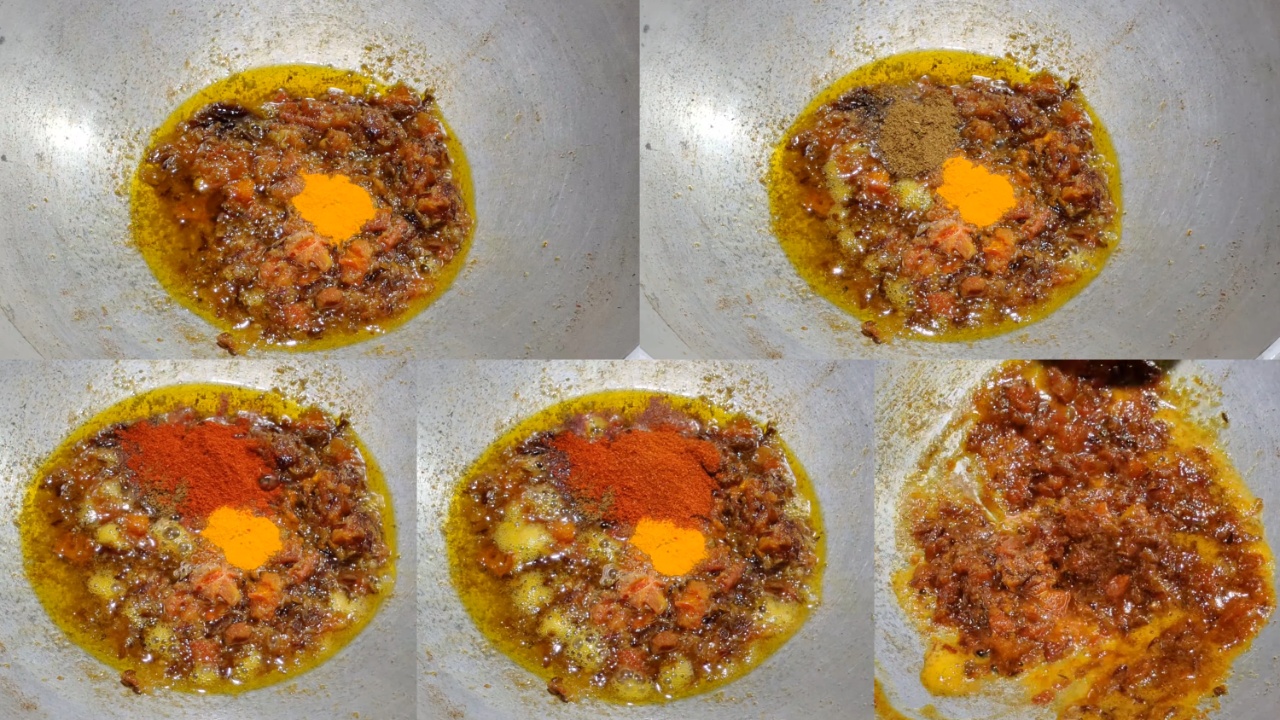
6. To prevent the spices from burning, add a small amount of water. Stir continuously for 5 minutes, and then add just under 1 tbsp of salt. Mix well.
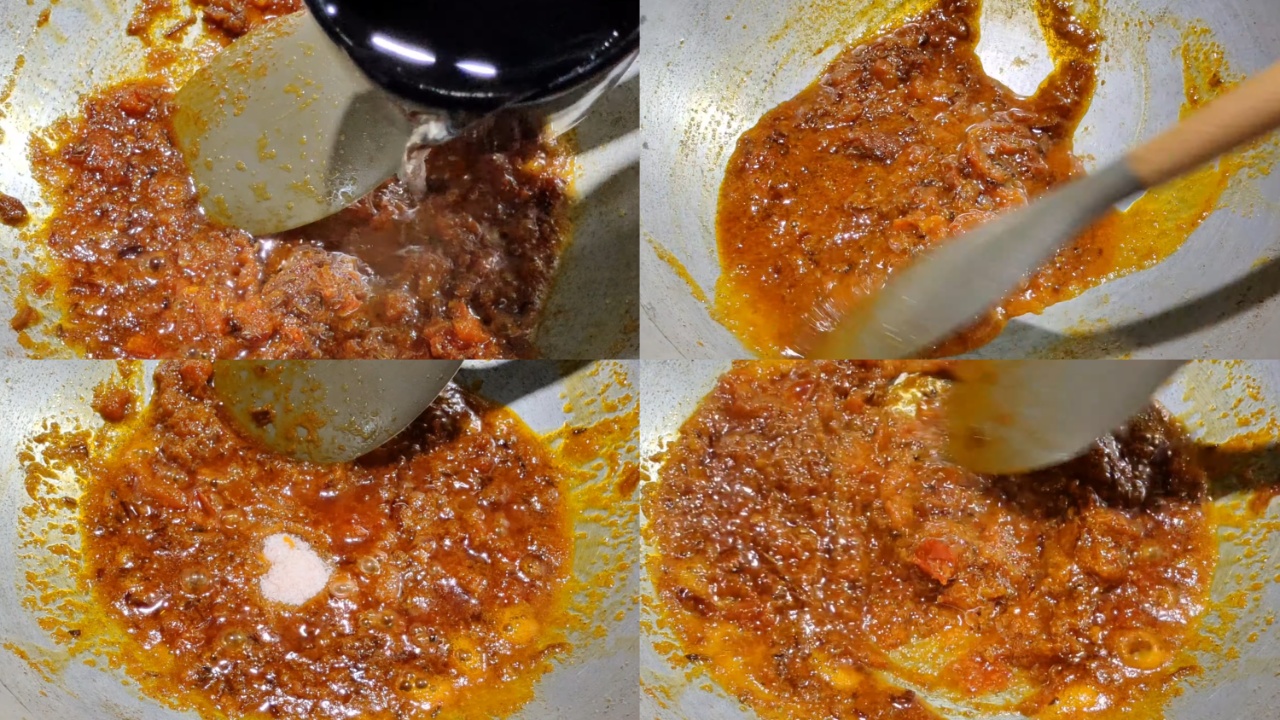
7. Add the boiled potatoes and stir them into the mixture. Afterward, pour in 1 cup of water and add the green chilis. Cover and let it simmer for 5 minutes.
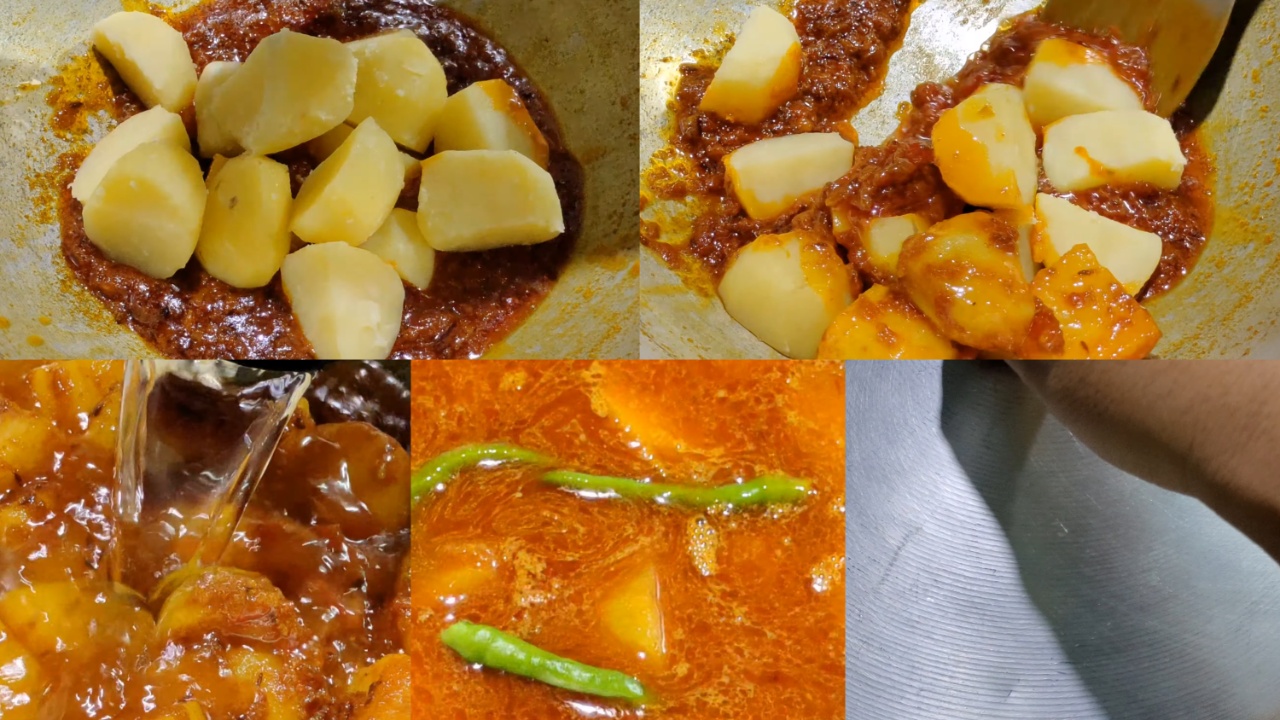
8. Uncover the wok; the curry should be nearly done. Add the roasted spice powder and mix it in. Cover it once more.
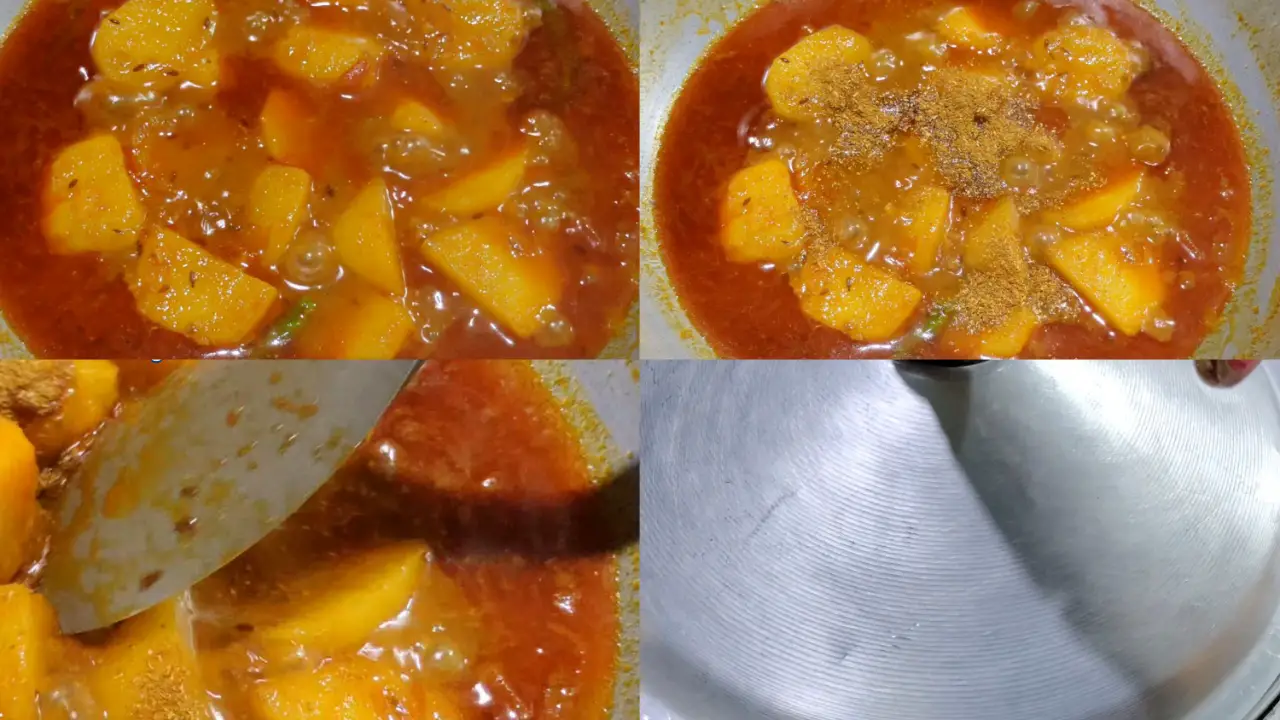
9. Uncover the wok; the curry should be ready at this point. Add the chopped coriander leaves and turn off the gas. Allow the curry to rest for a few minutes.
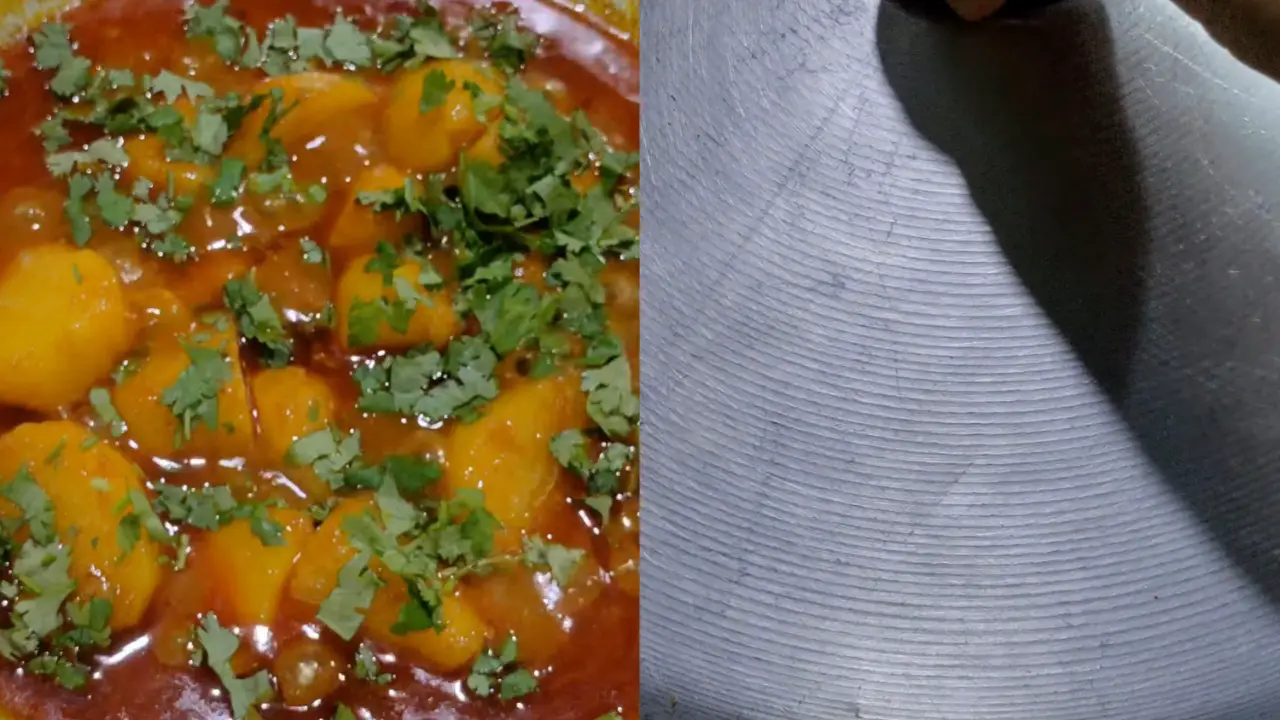
10. Transfer Potato Curry into a bowl.
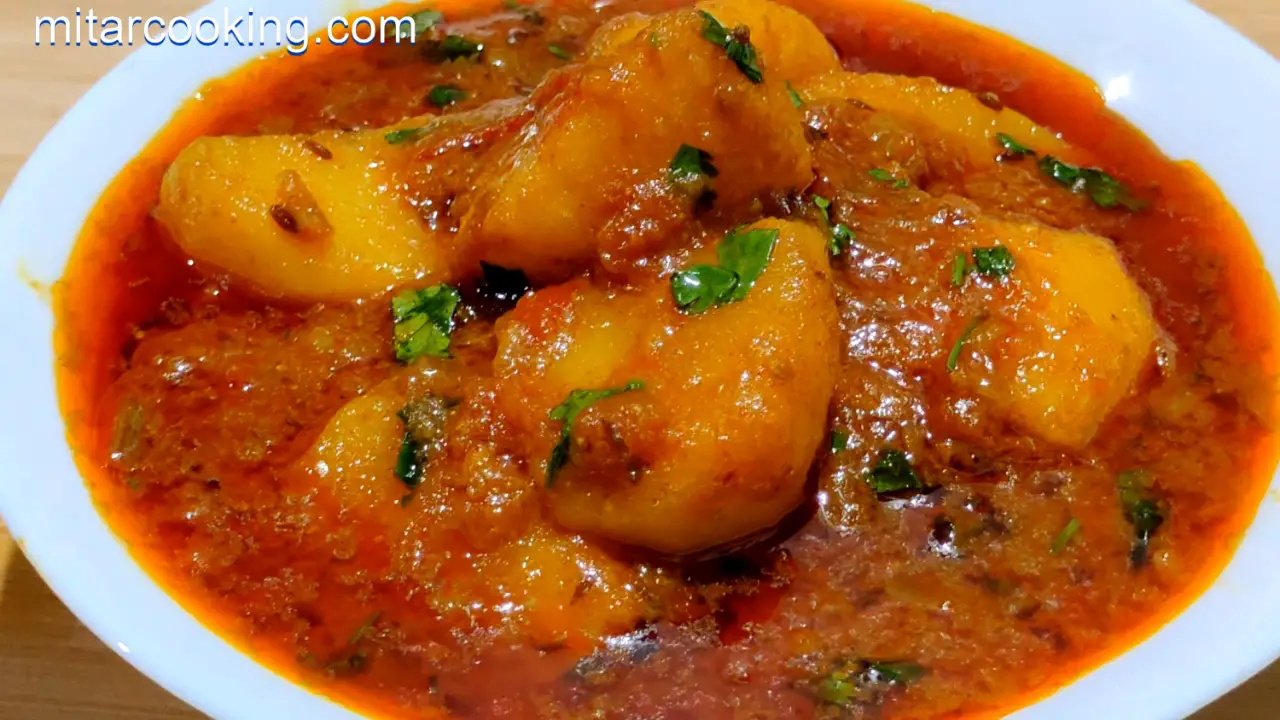
Pro Tips for Cooking Best Potato Curry
Choose the Right Potatoes: Opt for waxy or all-purpose potatoes like Yukon Gold or Russet. They hold their shape well when boiled and won’t turn mushy in the curry.
Boiling Potatoes: Boil the potatoes until they are just fork-tender, as they will continue to cook in the curry. Overcooking can lead to a mushy texture.
Heat the Oil Thoroughly: Ensure the mustard oil is heated properly before adding cumin seeds. This step enhances the oil’s flavor and eliminates any bitterness.
Balancing Spices: Adjust the quantity of red chili powder to suit your spice tolerance. Kashmiri red chili powder adds vibrant color without excessive heat.
Spice Roasting: Toasting the spices for the roasted spice powder is crucial. It releases their essential oils and intensifies the flavor. Be careful not to burn them.
Sautéing Onions and Tomatoes: Cook the onions until they are soft and translucent to build a flavorful base. Similarly, let the tomatoes cook down to remove excess moisture, intensifying their taste.
Control the Spice Level: Remember that green chilis and red chili powder can add heat. Adjust these according to your preference, or remove the seeds from green chilis for milder heat.
Consistency Matters: Adjust the amount of water to achieve your desired curry consistency. Add more for a thinner curry or less for a thicker one.
Simmering Time: Allow the curry to simmer after adding potatoes. This lets them absorb the flavors of the spices and the gravy.
Rest Before Serving: Let the potato curry rest for a few minutes after turning off the heat. This allows the flavors to meld, resulting in a more delicious dish when served.
Garnish Right: Fresh coriander leaves add a burst of freshness and color. You can also drizzle a few drops of lemon juice for a zesty twist.
These pro tips will help you master the art of making a delicious and aromatic potato curry that will impress your family and friends.
What to Serve with Potato Curry?
Potato curry is a versatile and flavorful dish that pairs well with a variety of accompaniments. Here are some popular options to serve with potato curry:
Steamed Rice: One of the classic choices is to serve potato curry with plain steamed white or brown rice. The rice can help balance the spiciness of the curry and soak up the delicious gravy.
Roti or Chapati: Indian flatbreads like roti or chapati are a perfect match for potato curry. They are great for scooping up the curry and adding a textural contrast.
Naan: Soft and fluffy naan bread is another excellent choice. It’s ideal for tearing into pieces and dipping into the curry.
Paratha: Potato curry pairs wonderfully with various types of parathas, such as plain, stuffed, or flaky layered parathas. They provide a delightful combination of flavors and textures.
Puri: If you’re looking for something indulgent, try serving potato curry with deep-fried puris. The crispy puris complement the creamy curry beautifully.
Bread: Simple slices of bread or dinner rolls can also be served with potato curry. It’s a convenient option if you’re looking for a quick and easy accompaniment.
Quinoa or Couscous: For a healthier twist, consider serving potato curry with quinoa or couscous. These grains can add a unique touch to your meal.
Ultimately, the choice of what to serve with potato curry depends on your personal preferences and dietary restrictions.
Feel free to experiment with different combinations to find the one that suits your taste best.
How Does Potato Curry Taste?
Potato curry is a delightful fusion of flavors that tantalizes the taste buds with a rich and aromatic profile. The taste of potato curry can be described as:
Spicy and Flavorful: The blend of spices, including cumin, turmeric, red chili powder, and the unique Kashmiri red chili powder, imparts a delightful spiciness to the curry. It’s flavorful without being overwhelmingly hot, making it suitable for a wide range of palates.
Savory and Earthy: Potatoes, when simmered in the curry, absorb the savory goodness of the spices and the gravy. They add an earthy and comforting element to the dish.
Tangy and Balanced: The addition of tomatoes and ginger-garlic paste provides a subtle tanginess that balances the spices. It adds a refreshing zing to the overall taste.
Aromatic: The roasted spice powder, with its toasted coriander seeds, cumin seeds, and dry red chilies, contributes a delightful aroma that wafts through your kitchen and enhances the curry’s appeal.
Creamy and Comforting: The combination of boiled potatoes and the simmered gravy results in a creamy and comforting texture. The potatoes become tender and soak up the flavorful sauce, creating a satisfying mouthfeel.
Herbaceous: The addition of fresh coriander leaves towards the end of cooking adds a touch of freshness and a mild herbal note to the dish.
Overall, potato curry offers a well-balanced, savory, and aromatic taste that’s both comforting and satisfying.
Potato Curry Alternatives
While potato curry is a beloved dish, there are numerous delightful alternatives to explore in the world of curries.
Here are some enticing options to consider when you’re in the mood for something different:
Chickpea Curry: Swap out potatoes for chickpeas to create a protein-rich curry. The chickpeas soak up the flavors of the spices and tomato-based gravy.
Cauliflower Curry: Cauliflower florets can be the star of the show in this curry, absorbing the spicy and aromatic sauce.
Paneer Curry: Cubes of Indian cottage cheese, known as paneer, make for a creamy and satisfying curry. It’s a vegetarian favorite.
Lentil Curry (Dal): Various lentils, such as yellow or red lentils, can be used to make a hearty and nutritious curry.
Mushroom Curry: Sliced mushrooms can be cooked in a rich and flavorful curry sauce for a unique and savory twist.
Eggplant Curry: Roasted and mashed eggplant combined with spices creates a smoky and distinctive curry.
Mixed Vegetable Curry: Use an assortment of vegetables like carrots, peas, beans, and bell peppers to create a colorful and wholesome curry.
Butter Chicken (Murgh Makhani): For those who enjoy non-vegetarian options, tender chicken pieces in a creamy tomato-based gravy make for a sumptuous curry.
Tofu Curry: Replace meat or paneer with tofu for a vegan alternative. Tofu readily absorbs the flavors of the curry sauce.
Pumpkin Curry: Cooked pumpkin chunks in a coconut or yogurt-based curry sauce offer a sweet and savory experience.
Jackfruit Curry: Unripe jackfruit, with its meaty texture, can be used as a plant-based substitute for meat in curries.
These curry alternatives provide a diverse range of flavors and ingredients to cater to various tastes and dietary preferences.
Whether you’re a vegetarian, vegan, or a meat enthusiast, there’s a curry variation to suit your cravings and culinary adventures.
Recipe Card:
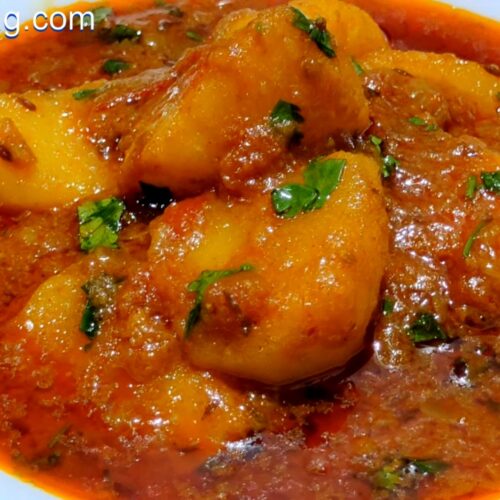
Potato Curry | Aloo Curry | Alur Torkari
Ingredients
- 400 grams Potato (cut into halves, boiled & peeled)
- 100 grams Tomato (chopped)
- 50 grams Onion (chopped)
- 2 tbsp Ginger garlic paste
- ½ tbsp Cumin powder
- 1 tbsp Roasted spice powder (coriander seeds + cumin seeds + dry red chili dry roasted & grounded)
- 1 tbsp Kashmiri red chili powder
- 1 tbsp Red chili powder
- 1 tbsp Turmeric powder
- 3 pieces Green chili
- 5 grams Coriander leaves
- ½ tbsp Cumin seed
- 3 tbsp Mustard oil
- Salt to taste
Instructions
- Preheat the Cooking Wok: Begin by placing a wok on your gas stove and heating it. Once the wok is hot, add 3 tablespoons of mustard oil, and allow it to heat up until it shimmers.
- Infusing Aromatic Flavors: As the oil reaches the right temperature, introduce cumin seeds into the sizzling oil. Sauté the seeds until they release a fragrant aroma. Then, add finely chopped onions to the wok. Continue sautéing the onions for about 3 minutes until they become translucent and lightly golden.
- Tomato Elegance: Now, it's time to bring in the chopped tomatoes. Add them to the wok and sauté for an additional 2 minutes. Watch as the tomatoes soften and release their natural juices.
- Ginger-Garlic Magic: Once the tomatoes have cooked down and most of their moisture has evaporated, incorporate the ginger-garlic paste. Stir it in, and allow it to cook until the raw smell dissipates. This step infuses the curry with rich flavors.
- Spice Medley: Add a vibrant blend of spices to the mix. Sprinkle in turmeric powder, cumin powder, Kashmiri red chili powder, and regular red chili powder. Thoroughly combine the spices with the aromatic base. To prevent burning, add a small amount of water, and continue stirring for 5 minutes. Finally, season the curry with just under 1 tablespoon of salt, ensuring all ingredients are well incorporated.
- Potato Integration: Incorporate the boiled potatoes into the fragrant mixture. Gently stir to coat the potatoes with the flavorful spices. To create a luscious gravy, pour in 1 cup of water and add green chilis for a touch of heat. Cover the wok and let it simmer for approximately 5 minutes.
- Spice Harmony: Uncover the wok; your curry should be nearly complete. Now, it's time to enhance the flavor profile. Add the roasted spice powder and carefully blend it into the curry. Once mixed, cover the wok again for a brief moment.
- Finishing Touch: Uncover the wok; your potato curry should be ready at this point. For a burst of freshness and color, introduce finely chopped coriander leaves to the mix. Turn off the gas and let the curry rest for a few minutes to allow the flavors to meld.
- Presentation: Transfer the tantalizing Potato Curry into a serving bowl, ready to be enjoyed.
Video
Notes
Nutrition Info (Estimation Only)
Conclusion
Potato curry is a highly delectable and common dish made in almost every household.
This recipe offers a mouthwatering taste and an appealing appearance, pairing wonderfully with rice, roti, paratha, and even puri.
The aroma of the roasted spices adds to its savory appeal. You can enjoy this side dish for lunch or dinner.

